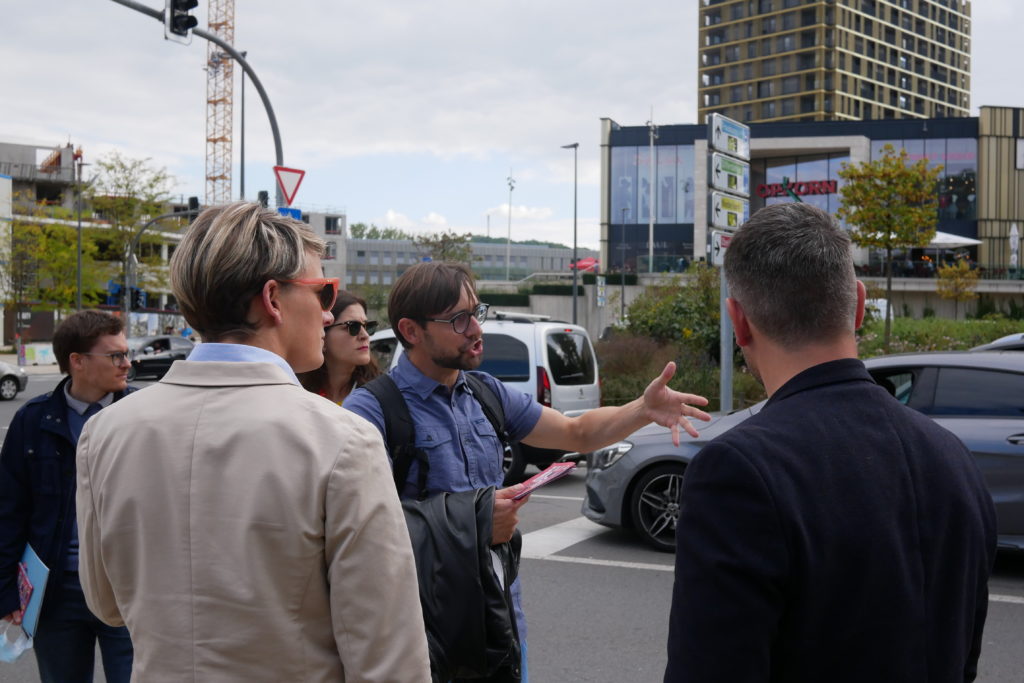How to enable sustainable urban commercial development in inner cities? How to cope with commercial concurrence between city centres and greenfield shopping centres? How to deal with commercial vacancies? What instruments and tools are there that decision-makers can use?
On Friday, 17. September 2021, CIPU organised an excursion to two Luxembourg cities to address these questions. During an afternoon, around 30 planners and experts from various cities and municipalities across the country learned about the approaches, among others of Differdange, the third biggest city of Luxembourg with 26.000 inhabitants.
The second half of the excursion led to Differdange
Differdange is a city built around a steel mill, featuring several centres that are geographically disconnected. The city has doubled in population during the past 15 years. This made it necessary to upscale urban services and to re-design the city centre. Much of the inner-city offer is still influenced by the consumer habits of steel workers: in footfall of the steel mills, restaurants, cafés, and bars dominate the urban environment, only few shops have been established in the inner city. With the steel mill slowly loosing importance for the urban economic activities, a transition of the urban commercial offer is taking place.

To support the re-orientation of the urban offer and to link the geographically disconnected centres, a new district has been developed. At the intersection of two major roads on a former landfill of an adjacent steel mill, the new district ‘Plateau Funiculaire’ links the different districts by providing different amenities and new functions.
The new district has been built around a large shopping centre, that has been strategically placed opposite of the still-running steel mill, at a transport axis through the city. With the development, the place presents the new centre of attraction in Differdange, offering shops, offices, and apartments for new and old inhabitants.
The transition of the urban commercial offer has led to an increasing number of commercial vacancies during the last 20 years. Despite the cities’ smaller size, the challenges Differdange faces are of similar nature to those of Esch-sur-Alzette (see Blog post on the first half of the CIPU Excursion). Both cities suffer from a decreasing inner city attractiveness due to high numbers of vacancies.
Instead of initiating a proprietary instrument, the municipality of Differdange has purchased two shop surfaces in the city centre and leases them to shop owners or new entrepreneurs. In doing so, the city does not rely on pre-definded procedures and rulings. Instead, it asks interested shop owners and entrepreneurs to develop applications, in which business ideas and shop concepts are described. The dossier is submitted to a selection committee. This committee consists of one representative of all political parties (also those that are not involved in municipal government), and of three citizens. A mix in gender, occupation and length of residency is respected.

The number of applications the municipality received exceeds the number of available shop surfaces. The two best concepts have been chosen, leading to two new shops being created in the municipality. One of them complements the urban commercial landscape with products for babies to young parents and the other sells gifts and goodies. The second shop was found by a Syrian refugee, who has been welcomed in Differdange during 2020. The shops benefit from marketing support of the public city channels.
More commercial surfaces of different kind (shops, bars, restaurants, etc.) will become available in near future. With the experiences collected, the municipality wants to continue efforts to revitalise the city-centre. For this, more commercial surfaces will be purchased in future and more specialised concepts matching concrete citizen requirements will be realised. This will help to address the issue of commercial vacancies with a versatile and pro-active instrument.

For more information, visit www.diffmix.lu, which is the citizen involvement platform of the municipality (available in English, French and German) and the municipal website of the city of Differdange: www.differdange.lu
For more information or for comments, please contact the author of this article: sebastian.hans@spatialforesight.eu







